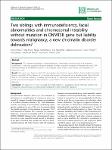Two siblings with immunodeficiency, facial abnormalities and chromosomal instability without mutation in DNMT3B gene but liability towards malignancy; a new chromatin disorder delineation?
Polityko, Anna
Khurs, Olga
Rumyantseva, Natalia
Naumchik, Irina
Kosyakova, Nadezda
Tönnies, Holger
Sperling, Karl
Neitzel, Heidemarie
Weise, Anja
Liehr, Thomas
Background: ICF syndrome (standing for Immunodeficiency, Centromere instability and Facial anomalies syndrome) is a very rare autosomal recessive immune disorder caused by mutations of the gene de novo DNAmethyltransferase 3B (DNMT3B). However, in the literature similar clinical cases without such mutations are reported, as well. Results: We report on a family in which the unrelated spouses had two female siblings sharing similar phenotypic features resembling ICF-syndrome, i.e. congenital abnormalities, immunodeficiency, developmental delay and high level of chromosomal instability, including high frequency of centromeric/pericentromeric rearrangements and breaks, chromosomal fragments despiralization or pulverization. However, mutations in DNMT3B could not be detected. Conclusion: The discovery of a new so-called ‘chromatin disorder’ is suggested. Clinical, molecular genetic and cytogenetic characteristics are reported and compared to other ‘chromatin disorders’.
Dateien zu dieser Publikation
Keine Lizenzangabe

